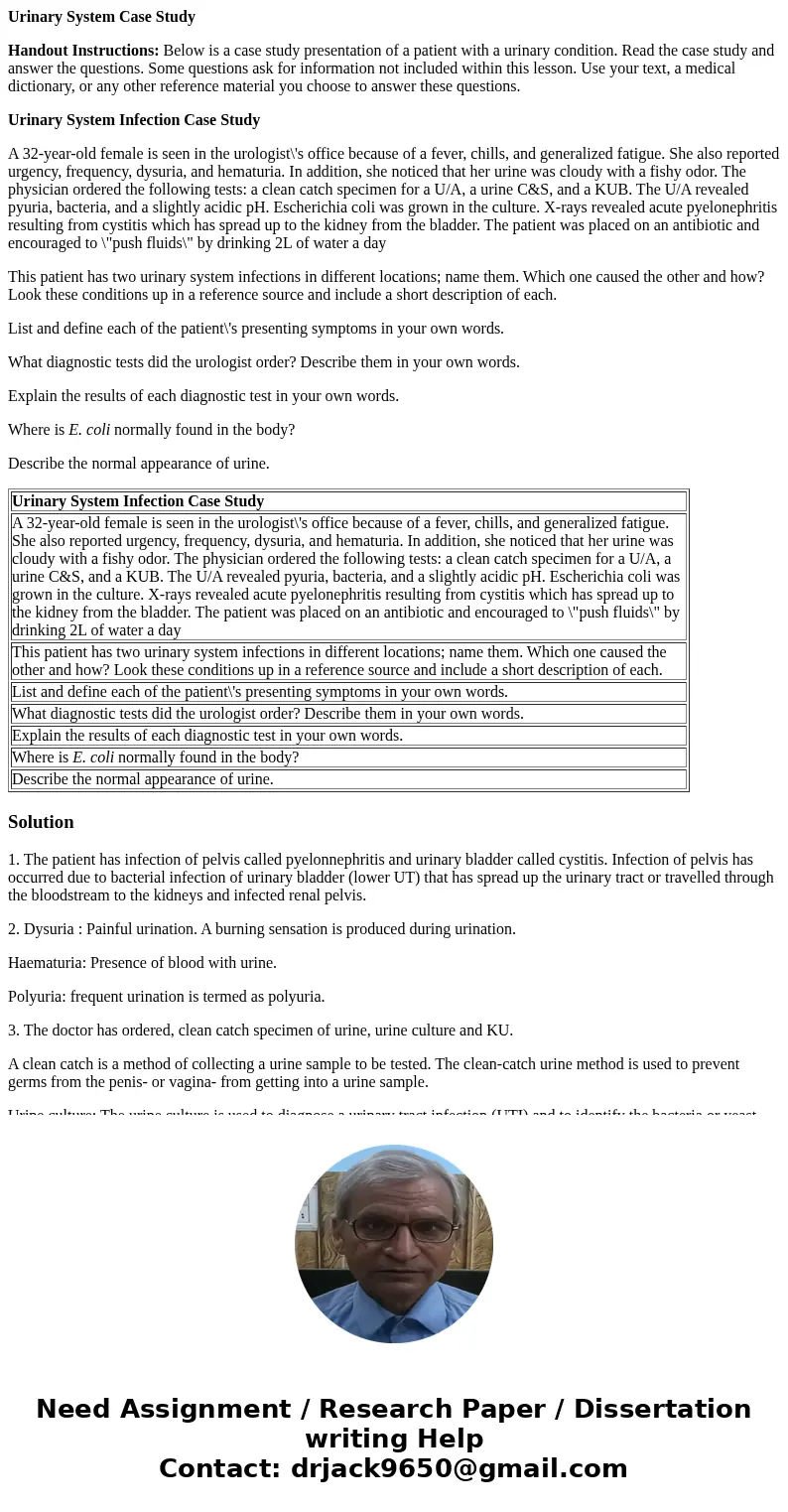Urinary System Case Study Handout Instructions Below is a ca
Urinary System Case Study
Handout Instructions: Below is a case study presentation of a patient with a urinary condition. Read the case study and answer the questions. Some questions ask for information not included within this lesson. Use your text, a medical dictionary, or any other reference material you choose to answer these questions.
Urinary System Infection Case Study
A 32-year-old female is seen in the urologist\'s office because of a fever, chills, and generalized fatigue. She also reported urgency, frequency, dysuria, and hematuria. In addition, she noticed that her urine was cloudy with a fishy odor. The physician ordered the following tests: a clean catch specimen for a U/A, a urine C&S, and a KUB. The U/A revealed pyuria, bacteria, and a slightly acidic pH. Escherichia coli was grown in the culture. X-rays revealed acute pyelonephritis resulting from cystitis which has spread up to the kidney from the bladder. The patient was placed on an antibiotic and encouraged to \"push fluids\" by drinking 2L of water a day
This patient has two urinary system infections in different locations; name them. Which one caused the other and how? Look these conditions up in a reference source and include a short description of each.
List and define each of the patient\'s presenting symptoms in your own words.
What diagnostic tests did the urologist order? Describe them in your own words.
Explain the results of each diagnostic test in your own words.
Where is E. coli normally found in the body?
Describe the normal appearance of urine.
| Urinary System Infection Case Study |
| A 32-year-old female is seen in the urologist\'s office because of a fever, chills, and generalized fatigue. She also reported urgency, frequency, dysuria, and hematuria. In addition, she noticed that her urine was cloudy with a fishy odor. The physician ordered the following tests: a clean catch specimen for a U/A, a urine C&S, and a KUB. The U/A revealed pyuria, bacteria, and a slightly acidic pH. Escherichia coli was grown in the culture. X-rays revealed acute pyelonephritis resulting from cystitis which has spread up to the kidney from the bladder. The patient was placed on an antibiotic and encouraged to \"push fluids\" by drinking 2L of water a day |
| This patient has two urinary system infections in different locations; name them. Which one caused the other and how? Look these conditions up in a reference source and include a short description of each. |
| List and define each of the patient\'s presenting symptoms in your own words. |
| What diagnostic tests did the urologist order? Describe them in your own words. |
| Explain the results of each diagnostic test in your own words. |
| Where is E. coli normally found in the body? |
| Describe the normal appearance of urine. |
Solution
1. The patient has infection of pelvis called pyelonnephritis and urinary bladder called cystitis. Infection of pelvis has occurred due to bacterial infection of urinary bladder (lower UT) that has spread up the urinary tract or travelled through the bloodstream to the kidneys and infected renal pelvis.
2. Dysuria : Painful urination. A burning sensation is produced during urination.
Haematuria: Presence of blood with urine.
Polyuria: frequent urination is termed as polyuria.
3. The doctor has ordered, clean catch specimen of urine, urine culture and KU.
A clean catch is a method of collecting a urine sample to be tested. The clean-catch urine method is used to prevent germs from the penis- or vagina- from getting into a urine sample.
Urine culture; The urine culture is used to diagnose a urinary tract infection (UTI) and to identify the bacteria or yeast causing the infection. Results of a urine culture are often interpreted in conjunction with the results of a urinalysis and with regard to how the sample was collected and whether symptoms are present. Typically, the presence of a single type of bacteria growing at high colony counts is considered a positive urine culture.
KUB; KUB stands for kidneys, ureters and bladder and refers to a diagnostic technique of radio imaging of these three parts of body to determine any type of inflammation in them.
5. E. Coli are normally found in the lower parts of small and in large intestine.
6. Normal urine appears pale yellow in colour, hqving pH within the range of 5.5 to 7 with an average of 6.2.


 Homework Sourse
Homework Sourse